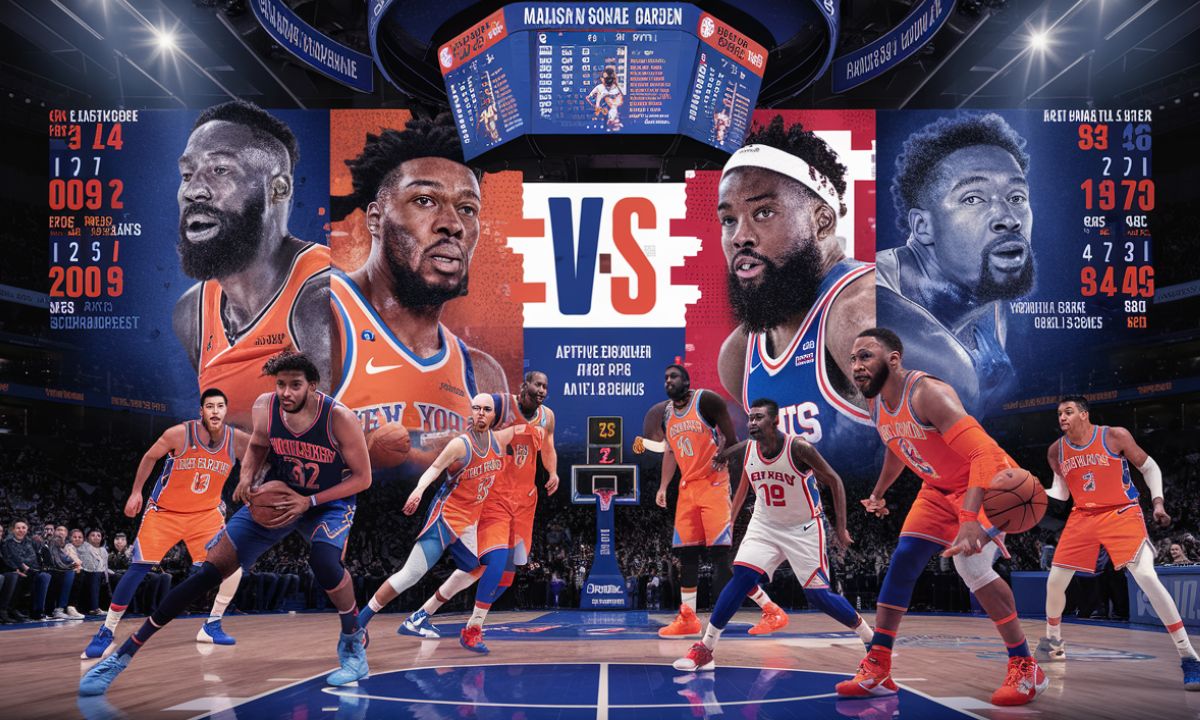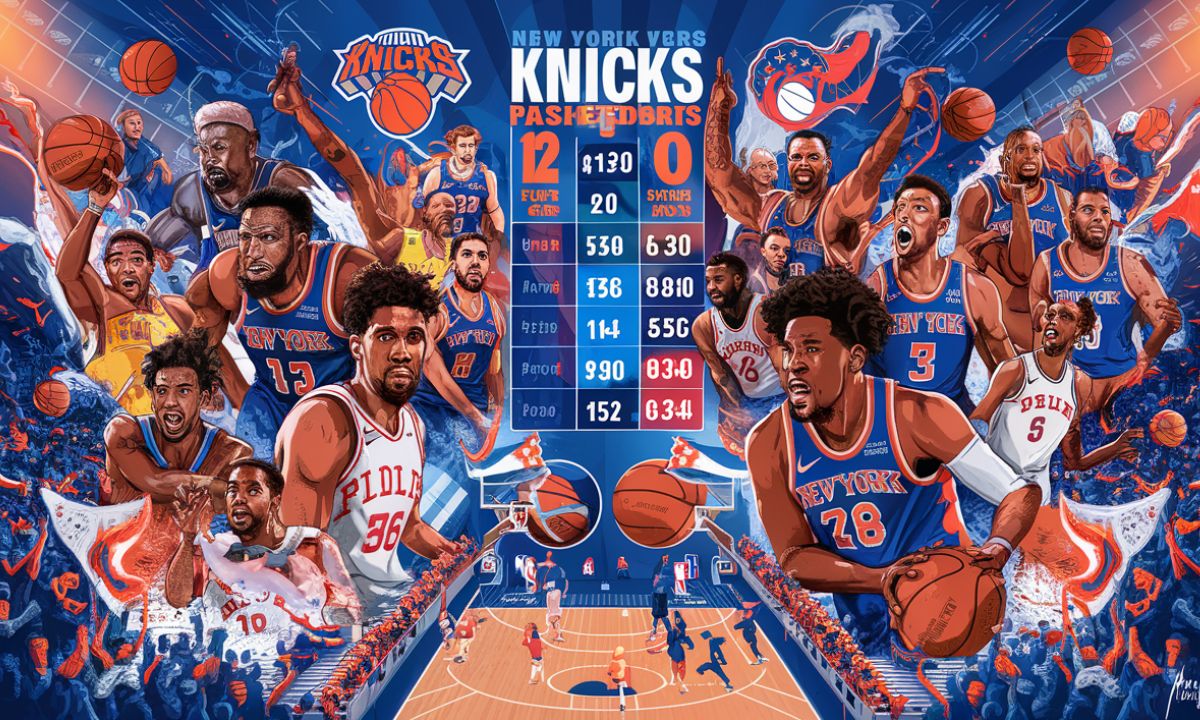The rivalry between the New York Knicks and the Philadelphia 76ers is one of the most storied in basketball history. Each matchup provides an exciting opportunity for players to shine and teams to showcase their strategies.
This analysis delves into the detailed player stats from their recent clash, highlighting key performances and team dynamics.
Key Player Stats: Knicks vs 76ers Match
Understanding player contributions is essential for analyzing game outcomes. In this matchup, several players stood out, influencing their teams’ performances significantly.
New York Knicks: Top Performers
The Knicks had several standout players who played crucial roles in their victory:
- Julius Randle: Randle was a powerhouse, scoring 28 points, grabbing 12 rebounds, and dishing out 6 assists. His versatility allowed the Knicks to stretch the floor effectively.
- Jalen Brunson: The point guard contributed 24 points and 8 assists, showcasing exceptional ball-handling and decision-making, especially during critical moments.
- RJ Barrett: With 20 points, Barrett displayed his ability to attack the rim and create scoring opportunities.
Notable Contributions
Beyond the star players, role players made significant impacts:
- Josh Hart: Although he scored only 8 points, his 10 rebounds and relentless defense were vital to the Knicks’ success.
- Mitchell Robinson: He anchored the defense with 3 blocks and contributed 9 rebounds, proving essential in the paint.
Philadelphia 76ers: Top Performers
The 76ers also had key players step up:
- Joel Embiid: The center dominated with 30 points and 10 rebounds, solidifying his status as an MVP candidate.
- James Harden: He added 22 points and 9 assists, although his shooting efficiency was a concern, hitting only 40% from the field.
- Tobias Harris: Contributed 18 points, offering valuable support on offense.
Notable Contributions
Role players for the 76ers also made their presence felt:
- Tyrese Maxey: Scored 16 points, providing a spark off the bench, though his defense could have been better.
- P.J. Tucker: Contributed 4 points, but his leadership and defensive prowess were crucial in keeping the game competitive.
Team Performance and Statistical Comparison

Overall Team Stats
Analyzing the overall team stats reveals much about the game dynamics:
| Team | Points Scored | Field Goal % | 3-Point % | Free Throw % | Total Rebounds |
| New York Knicks | 112 | 48% | 35% | 80% | 45 |
| Philadelphia 76ers | 105 | 46% | 30% | 75% | 40 |
The Knicks outperformed the 76ers in crucial areas, particularly in rebounding and free throw shooting.
Head-to-Head Comparison
When comparing the two teams’ stats, the Knicks had distinct advantages:
- Rebounding: The Knicks secured 45 rebounds compared to the 76ers’ 40.
- Free Throw Efficiency: The Knicks shot 80% from the line, while the 76ers managed only 75%, highlighting a critical difference.
Field Goal and Three-Point Shooting Efficiency
Field Goal Efficiency
- Knicks: Shot 48% from the field, demonstrating effective shot selection and offensive execution.
- 76ers: At 46%, they missed opportunities, especially in the second half.
Three-Point Shooting
- Knicks: Hit 35% of their three-point attempts, with Randle and Brunson leading the charge.
- 76ers: Struggled at 30%, as Harden and Harris failed to find their rhythm.
Rebounding and Second-Chance Opportunities
Rebounding is crucial in basketball, often determining possession and scoring opportunities.
Total Rebounds Comparison
| Team | Offensive Rebounds | Defensive Rebounds | Total Rebounds |
| New York Knicks | 12 | 33 | 45 |
| Philadelphia 76ers | 8 | 32 | 40 |
The Knicks excelled in both offensive and defensive rebounding, creating second-chance opportunities crucial for maintaining their lead.
Impact of Rebounding on the Game
The Knicks’ rebounding advantage allowed them to control the game’s pace and limit the 76ers’ scoring chances. This advantage was particularly evident during critical stretches when every possession mattered.
Read More:What is Kiolopobgofit Used For?
Ball Movement and Turnovers
Effective ball movement and minimizing turnovers are vital components of success in basketball.
Assists Comparison
| Team | Total Assists | Turnovers |
| New York Knicks | 25 | 12 |
| Philadelphia 76ers | 20 | 15 |
The Knicks showcased superior ball movement, resulting in more assists and fewer turnovers. This efficiency helped maintain their offensive flow.
Analysis of Team Ball Movement
The Knicks’ ability to share the ball and create open shots was a key factor in their success. Brunson’s playmaking, combined with Randle’s ability to draw defenders, opened up scoring options for others.
Defensive Highlights and Key Moments
Defense often defines the outcome of close games, and this matchup was no different.
Knicks’ Defensive Execution
The Knicks executed their defensive game plan effectively:
- Switching Defense: They frequently switched on screens, complicating the 76ers’ attempts to find mismatches.
- Key Stops: In crucial moments, the Knicks forced turnovers and contested shots, particularly in the fourth quarter.
76ers’ Defensive Challenges
The 76ers faced several defensive issues:
- Inconsistent Communication: Defensive breakdowns allowed Knicks players to get open looks, especially from three-point range.
- Foul Trouble: Key players, like Embiid, faced foul trouble, limiting their effectiveness on defense.
Step-by-Step Breakdown: How the Knicks Secured the Victory

Controlling the Offensive Flow
From the outset, the Knicks established their offensive rhythm. Randle and Brunson effectively controlled the pace, ensuring that the ball moved quickly and efficiently. Their ability to score in transition kept the 76ers on their heels.
Dominating the Rebounding Battle
The Knicks’ focus on rebounding paid off. By securing both offensive and defensive boards, they limited the 76ers’ second-chance points. This dominance allowed them to control the tempo and limit the 76ers’ offensive opportunities.
Late-Game Defensive Execution
In the final moments, the Knicks tightened their defense. They applied pressure, forcing the 76ers into rushed shots and turnovers. Key defensive plays by Robinson and Hart were pivotal in maintaining the lead.
Final Score and Summary
The game concluded with the Knicks defeating the 76ers 112-105. This score reflects a hard-fought battle, with both teams displaying their strengths and weaknesses.
Summary of How the Game Unfolded
The Knicks established an early lead, leveraging their rebounding and efficient shooting. The 76ers fought back, led by Embiid’s dominance, but ultimately fell short due to turnovers and defensive lapses.
Key Takeaways from Knicks vs 76ers Match Player Stats
Analyzing the player stats from this matchup reveals several key takeaways:
- Importance of Rebounding: The Knicks’ rebounding advantage was crucial in controlling the game.
- Efficiency Matters: Field goal and free throw percentages directly impacted the outcome, emphasizing the need for teams to capitalize on scoring opportunities.
- Role Players Shine: Contributions from role players, like Hart and Robinson, can be the difference in close games.
- Defensive Discipline: Teams must maintain communication and execution on defense to prevent breakdowns that can lead to easy baskets.
Conclusion
The Knicks vs 76ers match provided a comprehensive view of how individual performances and team strategies shaped the game. The Knicks’ superior rebounding, efficient shooting, and strong late-game defense were pivotal in their victory.
Understanding these dynamics not only highlights the strengths and weaknesses of each team but also sets the stage for future matchups. Both teams will need to analyze these stats to make necessary adjustments as the season progresses.
Frequently Asked Questions
Who recorded the highest score in the Knicks vs. 76ers game?
Joel Embiid led the scoring with 30 points, showcasing his offensive prowess.
How did the Knicks win against the 76ers?
The Knicks secured victory through superior rebounding, efficient shooting, and strong late-game defense.
What was the biggest weakness for the 76ers in this match?
Inconsistent communication on defense and high turnover rates hampered their performance.
How did Josh Hart impact the game without scoring much?
Hart’s defense and rebounding were vital in maintaining the Knicks’ momentum, proving that contributions come in many forms.
What are the key takeaways from this game for future matchups?
Teams must prioritize rebounding, maintain shooting efficiency, and ensure defensive discipline to succeed in future games.
What role did turnovers play in the game?
Turnovers significantly impacted the 76ers, as they had 15 compared to the Knicks’ 12, contributing to their defeat.
please read our other site for more info:petwellness786.info












